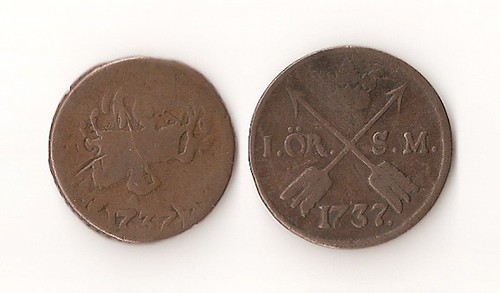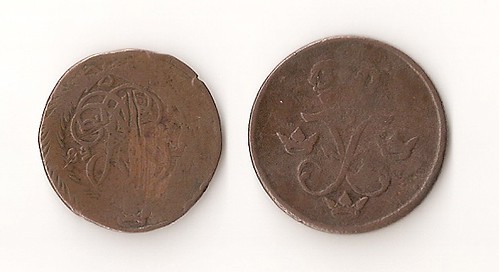
PREV ARTICLE
NEXT ARTICLE
FULL ISSUE
PREV FULL ISSUE
RUSSIAN COPPER STRUCK ON SWEDISH UNDERTYPE  In response to last week's installment of Steve Bishop's series, Ken Spindler of San Diego, CA writes: I understand that Steve Bishop's series on overstruck 18th century Russian coppers has only just begun, so perhaps I should patiently wait to see whether he goes off on any tangents. Nah. This is my Russian 1758 1 kopek which was clearly struck over a 180-degree-rotated Swedish 1737 1 ore coin. I believe the host coin must have been cut down*, because whereas the weight standard of a 1737 Swedish 1 ore was 14.2 grams, the weight standard of a Russian 1758 1 kopek was only 10 grams. My heavily-worn Swedish 1737 1 ore weighs 13.54 grams, and it's nice and round. My even slicker coin of two countries weighs 10.67 grams, and it's not perfectly round. In addition to the bold 1737 date in the correct style between arrow feathers showing on the obverse of the inverted Russian coin, at 6:00 in scan, the bottom crown of the 3 Swedish crowns still displays on the reverse of the Russian coin, in the same position. (Both coins have medal alignment.) I don't think they'll slab. *Seems like a lot of work to produce a very small denomination coin! Thanks. Ken provided the images above. Neat coins. I put Steve Bishop in touch with Ken and they've been corresponding. -Editor
Steve adds: Here's a link to an online article about Russian overstrikes that mentions the Swedish undertypes as well as some from Sadagura (Moldavia and Wallachia) coinage (1772-74). Russian overstruck coins were a common thing in 1700s. In the early 1700s when Peter I decided to change the Russian currency to decimal coinage, a lot of silver and copper were needed. As Russia struggled to source enough silver for her own coinage, foreign coins were imported to temporary solve this problem. The first sign of this was in 1655 where German thalers, Spanish patagons and other foreign coins were countermarked. Some of these coins were then overstruck. This soon became an easy solution to remove coins that were no longer suited for circulation as it was cheaper than melting down coins and make new planchets. There might have been some politics involved such as increasing the denomination due to massive inflation. Another reason might be to remove the previous Tsar / Tsarina image as soon as possible from circulation. This however meant that coins looked "uglier" or unique as underlying image impacted the overall look. Some overstruck coins can be interesting as the original host coins might have started out to be uncommon, making it rarer than other coins. In fact, all overstruck coins are unique which makes this section very quite interesting. This practice stopped in the early 1800s as Russia increased mining production and minting technology improved. To read the complete article, see:  Wayne Homren, Editor The Numismatic Bibliomania Society is a non-profit organization promoting numismatic literature. See our web site at coinbooks.org. To submit items for publication in The E-Sylum, write to the Editor at this address: whomren@gmail.com To subscribe go to: https://my.binhost.com/lists/listinfo/esylum All Rights Reserved. NBS Home Page Contact the NBS webmaster 
|